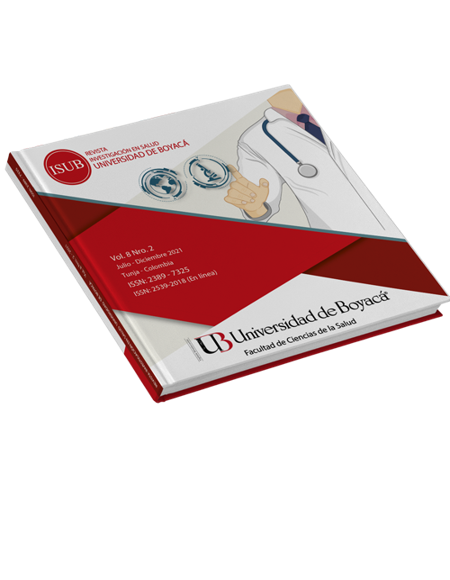Aborto espontáneo en estudiantes universitarias en Pamplona, Norte de Santander, en el periodo del año 2007 al 2016. Un estudio transversal
Miscarriage in University Students in Pamplona (Norte de Santander, Colombia) during 2007-2016. A Cross Sectional Study
Contenido principal del artículo
Resumen
Introducción: El aborto espontáneo se refiere al fenómeno por el cual un embrión o feto se descarga automáticamente del cuerpo de la madre por alguna razón involuntaria, generalmente a las 20 semanas del embarazo. Entre el 15% y el 20% de todos los embarazos tienen riesgo de aborto espontáneo y alrededor de un 10% terminarán siendo abortos espontáneos. Metodología: Estudio descriptivo transversal con intención analítica. Se tomaron los datos de 207 historias clínicas del archivo del hospital público de Pamplona (Norte de Santander, Colombia) de mujeres gestantes universitarias, correspondientes al periodo 2007-2016. Se consideró aborto espontáneo la variable reportada en la historia clínica. Se estimó la frecuencia de aborto espontáneo y se exploró la asociación con diferentes variables clínicas y sociodemográficas en estudiantes universitarias. Se construyeron modelos de regresión binomial simple y multivariable, para estimar la asociación entre las variables. Resultados: Se reportaron 15 abortos espontáneos (7,5%). Aquellas quienes no se habían aplicado la vacuna antitetánica y quienes no se realizaron citología durante los 12 meses previos presentaron los mayores porcentajes de abortos espontáneos (16,7% y 15,2%, respectivamente). Las mujeres que acusaron haber estado hospitalizadas (RP: 4,01; IC95%: 1,69-9,49) y haber tenido abortos previamente (RP: 7,53; IC95%: 3,02-18,77) mostraron asociación con el aborto espontáneo. Conclusión: Se pudo estimar que la proporción de abortos espontáneos es similar a lo reportado en otros estudios; no obstante, son necesarias investigaciones adicionales que evalúen la relación entre el aborto espontáneo y factores individuales y contextuales para generar estrategias que disminuyan estas cifras.
Palabras clave
Descargas
Datos de publicación
Perfil evaluadores/as N/D
Declaraciones de autoría
Indexado en
- Sociedad académica
- Universidad de Boyacá
- Editorial
- Universidad de Boyacá
Detalles del artículo
Referencias (VER)
Dugas C, Slane VH. Miscarriage. En: StatPearls [Internet]. Treasure Island (FL): StatPearls Publishing; 2019. Disponible en: https://pubmed.ncbi.nlm.nih.gov/30422585/
Alves C, Rapp A. Spontaneous Abortion (Miscarriage) [Internet]. StatPearls [Internet]. Treasure Island (FL): StatPearls Publishing; 2020. Disponible en: https://www.ncbi.nlm.nih.gov/books/NBK560521/
Kanmaz AG, Inan AH, Beyan E, Budak A. The effects of threatened abortions on pregnancy outcomes. Ginekol Pol [Internet]. 2019;90(4):195-200. https://doi.org/10.5603/GP.a2019.0035
Farrell T, Owen P. The significance of extrachorionic membrane separation in threatened miscarriage. BJOG An Int J Obstet Gynaecol [Internet]. 1996;103(9):926-8. https://doi.org/10.1056/NEJM198812013192214
Hertz-Picciotto I, Samuels SJ. Incidence of early loss of pregnancy. N Engl J Med [Internet]. 1988;319(22):1483-4. https://doi.org/10.1056/NEJM198807283190401
Mauro C, Juan Antonio G-V, Marcos M, Antonio P, Jose B. Female obesity increases the risk of miscarriage of euploid embryos. Fertil Steril [Internet]. 2020; https://doi.org/10.1016/j.fertnstert.2020.09.139
Nybo Andersen, AM; Wohlfahrt, J; Christens, P; Olsen, J; Melbye M. Maternal age and fetal loss: population based register linkage study. BMJ [Internet]. 2000;320(7251):1708-12. https://doi.org/10.1136/bmj.320.7251.1708
Ellenberg JH. Selection Bias in Observational and Experimental Studies. Stat Med [Internet]. 1994;13:557-67. https://doi.org/10.1002/sim.4780130518
Delgado-Rodríguez M, Llorca J. Bias. J Epidemiol Community Health [Internet]. 2004;58(8):635-41. https://doi.org/10.1136/jech.2003.008466
Rossen L, Ahrens K, Branum A. Trends in Risk of Pregnancy Loss Among US Women, 1990-2011. Paediatr Perinat Epidemiol [Internet]. 2018;32(1):19.29. https://doi.org/10.1111/ppe.12417
Hu X, Miao M, Bai Y, Cheng N, Ren X. Reproductive factors and risk of spontaneous abortion in the jinchang cohort. Int J Environ Res Public Health [Internet]. 2018;15(11). https://doi.org/10.3390/ijerph15112444
Feodor Nilsson S, Andersen PK, Strandberg-Larsen K, Nybo Andersen AM. Risk factors for miscarriage from a prevention perspective: A nationwide follow-up study. BJOG An Int J Obstet Gynaecol [Internet]. 2014;121(11):1375-85. https://doi.org/10.1111/1471-0528.12856
Moradinazar M, Najafi F, Nazar ZM, Hamzeh B, Pasdar Y, Shakiba E. Lifetime Prevalence of Abortion and Risk Factors in Women: Evidence from a Cohort Study. J Pregnancy [Internet]. 2020;4871494. https://doi.org/10.1155/2020/4871494
Adjei G, Enuameh Y, Asante KP, Baiden F, A Nettey OE, Abubakari S, et al. Predictors of abortions in Rural Ghana: A cross-sectional study. BMC Public Health [Internet]. 2015;15(1):1-7. https://doi.org/10.1186/s12889-015-1572-1
Bouquet RI. Aborto espontáneo miscarriage. Liberabit [Internet]. 2012;18(1):53-7. Disponible en: http://www.scielo.org.pe/pdf/liber/v18n1/a07v18n1.pdf
Pérez Pinto MG, Cruz León A, Arriaga Zamora RM. Significado del cuidado familiar como red de apoyo en las embarazadas en una comunidad de Tabasco. Rev Cuid [Internet]. 2019;8(15):45. https://doi.org/10.22201/fesi.23958979e.2019.8.15.69156
Ozawa N, Ogawa K, Sasaki A, Mitsui M, Wada S, Sago H. Maternal age, history of miscarriage, and embryonic/fetal size are associated with cytogenetic results of spontaneous early miscarriages. J Assist Reprod Genet [Internet]. 2019;36(4):749-57. https://doi.org/10.1007/s10815-019-01415-y
Brown S. Miscarriage and its associations. Semin Reprod Med [Internet]. 2008;26(5):391-400. https://doi.org/10.1055/s-0028-1087105
Kleinhaus K, Perrin M, Friedlander Y, Paltiel O, Malaspina D, Harlap S. Paternal age and spontaneous abortion. Obstet Gynecol [Internet]. 2006;108(2):369-77. https://doi.org/10.1097/01.AOG.0000224606.26514.3a
Rowland Hogue CJ, Cates W, Tietze C. The effects of induced abortion on subsequent reproduction. Epidemiol Rev [Internet]. 1982;4(1):66-94. https://doi.org/10.1093/oxfordjournals.epirev.a036252
Infante-Rivard C, Gauthier R. Induced abortion as a risk factor for subsequent fetal loss. Epidemiology [Internet]. 1996;7(5):540-2. https://doi.org/10.1097/00001648-199609000-00017
Xu G, Wu Y, Yang L, Yuan L, Guo H, Zhang F, et al. Risk factors for early miscarriage among Chinese: A hospital-based case-control study. Fertil Steril [Internet]. 2014;101(6):1663-70. https://doi.org/10.1016/j.fertnstert.2014.02.013
Regan L, Braude PR, Trembath PL. Influence of past reproductive performance on risk of spontaneous abortion. Br Med J [Internet]. 1989;299(6698):541-5. https://doi.org/10.1136/bmj.299.6698.541
Stirrat GM. Recurrent miscarriage I: definition and epidemiology. Lancet [Internet]. 1990;336(8716):673-5. https://doi.org/10.1016/0140-6736(90)92159-F
Qu F, Wu Y, Zhu YH, Barry J, Ding T, Baio G, et al. The association between psychological stress and miscarriage: A systematic review and meta-analysis. Sci Rep [Internet]. 2017;7(1):1-8. https://doi.org/10.1038/s41598-017-01792-3








